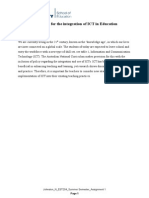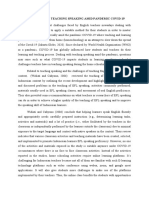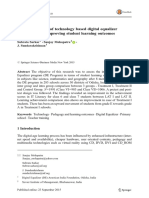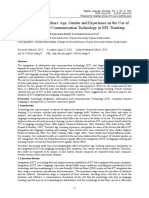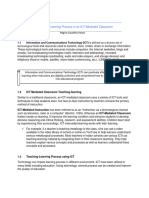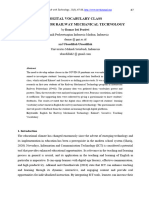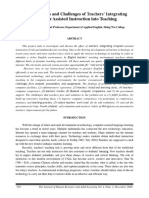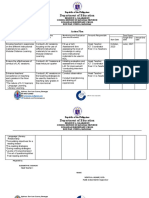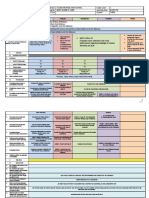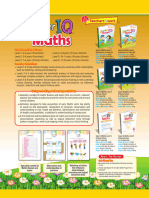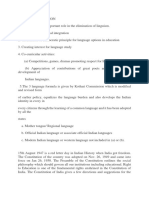Outline Astuti
Outline Astuti
Uploaded by
ppg.dinaanggraini00130Copyright:
Available Formats
Outline Astuti
Outline Astuti
Uploaded by
ppg.dinaanggraini00130Original Title
Copyright
Available Formats
Share this document
Did you find this document useful?
Is this content inappropriate?
Copyright:
Available Formats
Outline Astuti
Outline Astuti
Uploaded by
ppg.dinaanggraini00130Copyright:
Available Formats
Secondary school EFL Teacher and Students challenges of using ICT
Based Learning in New Normal
Theorigap:
a. ICT :
The term ICT generally refers to electronic equipment used to create, process, store, display,
transmit, and exchange information. In this context, ICT includes electronic technology and
digital devices, such as television, video, radio, DVD, telephone (whether landline or
cellular), satellite systems, computer and network hardware and software, and all equipment
and services related to these technologies, such as email and blogs and video conferencing
(UNESCO, 2007)
Hennessy et al. (2005) stated that ICT includes a variety of technical media which includes
hardware (projection technology, laptops, desktop computers, netbooks, tablets, cell phones,
data storage, and digital audio and visual equipment), software applications, and information
systems (Intranet, Internet, cloud computing).
ICT tools inflow into language learning and teaching has delivered an increasing
range ofpossible solutions for refining teaching and learning inputs, processes, and
outcomes (Pardede, 2012)
ICT also provides a variety of tools for educators trying to extend learning beyond the
classroom (Haygood, Garner, & Johnson, 2012).
Pardede’s (2011) stated that the trend of ICT use in EFL can be traced to the 1930s
when instructors used audiovisual tools to deliverncontent in the classroom, which
was followed by the use of audio recordings, television, films, video, and computers
in the trials to bring the target language and culture to students in the 1960s.
Ahmad (2012) reported that ICT integration to the class can boost students’ participation,
promote student-centered mode, endorse create a positive atmosphere, and improve the
students' writing performance.
ICT implementation in language teaching and learning process has been increasingly growing
(Suherdi, 2012 & Romero, 2008).
The literature suggests that some factors affect teachers’ willingness or unwillingness to use
technology in the learning process, including ICT tools availability, support from the school
administrators, and the variables related to teachers. Various studies (Hew & Brush, 2007; Li,
2007)
b. Teachers’ Perception of ICT Integration in EFL Learning
In the 2013 Curriculum, all subjects, including English, are indirectly insisted to use
technology-based learning tools to conform with the changing learning philosophy from
instructivism to constructivism (Hidayati, 2016).
According to Harendita (2013), although 80% of Indonesian schools had got access to the
Internet in 2011, only 39% of teachers used ICT during the teaching and learning process.
The studies of Hew and Brush (2007) and Li (2007) show that the variables related to
teachers are the most essential that determine teachers’ use of ICT in their teaching.
This is in line with Atkins and Vasu (as cited in Park & Son, 2009) who accentuated that
teachers' perceptions have a crucial influence on the use of ICT in English teaching.
Cope and Ward (2002) reported that teachers' perceptions of technology include 'how' and
'what' effects technology can bring to students. Thus, teachers' perceptions of technology
cover their ability to identify the potential of technology to motivate students Various studies
have revealed that teachers' positive perceptions tend to motivate their use of technology in
learning.
Galanouli, Murphy, and Gardner's (2004) study reveals that teachers with positive perceptions
view training in ICT worthwhile and are prone to use it in their teaching.
Teachers with positive perceptions are also more open toward the possible innovation
technology can bring about in learning, such as its impact on higher-order thinking skills and
language learning content acquisition (Baylor & Ritchie, 2002).
Angers and Machtmes (2005) reported that the successful technology integration in education
is highly determined by the teachers’ personal beliefs and concerns, and those beliefs and
concerns pursue their probability to employ ICT (Russell et al., 2003).
Angers and Machtmes (1999) affirmed that teachers who perceive ICT tools can be used to
augment lessons, motivate, and bring changes to their teaching strategies that tend to
confidently adopt the technology.
c. Advantages of Using ICT in EFL Learning and Teaching
Cowie and Jones (2009) indicated that ICT can foster educational objectives, including
knowledge selection and creation, collaboration, and reflection.
Uluyol and Ṣahin (2014, p. 67) reported that ICT use can make "lessons more interesting,
more enjoyable for both teachers and students, more diverse, more motivating and more
supportive of productive learning."
According to Yang and Chang (2012, p. 128), "technology has created opportunities for
learning to become a more interactive process between instructors and learners, as well as
among learners."
Al-Munawwarah (2014) reported that ICT use helps teachers to create interesting and
enjoyable learning activities, promoting learner autonomy, and to promote students’ learning
motivation.
Furthermore, Houcine (2011) pointed out five ICT use apparent impacts to support EFL
learning and teaching: (1) to help educators easily adapt teaching materials to meet the
circumstances, learner's needs, and responses; (2) to provide access to authentic materials on
the web; (3) to facilitate us to react upon and enables the use of recent/daily news; (4) to help
teacher combine or use alternately skills (listening and speaking, reading and writing,
speaking and writing) and media (text and images, text and audio, text, and 147 Journal of
English Teaching, (5) to enable teachers and/or students to focus on one specific aspect of the
lesson (grammar, pronunciation, vocabulary, etc.).
In line with that, Padurean and Margan (2009) listed four benefits of ICT use in the EFL
classroom: (1) ICT provides the capacity to control the presentation. Unlike books which
have a fixed presentation, computers can combine visual with listening materials, text with
graphics and pictures; (2) ICT offers novelty and creativity. ICT facilitates teachers to use
different materials for each lesson; (3) ICT provides fast feedback to students` answers
through error correction. Computers not only spot the mistake but also correct it and give the
appropriate advice; (4) ICT offers adaptability. Teachers can adapt computer programs to suit
their students` needs and levels of language knowledge. This makes computer programs more
learner-friendly, different from books which are produced in a single uniform format and
need to be taught irrespectively of students` problems.
d. Phenomenological gap:
The learning outcomes for several months during this pandemic have not been
optimal. The main factor lies in the inadequate use of ICT and teacher learning strategies,
even though various platforms and other ICTs are already advanced and there are still
some teachers who only use one or two of these platforms. There are also teachers who
only give assignments to students during this pandemic, even though the platform for
creating interesting learning content is already available.
Besides that, as students in the pandemic period that has been passed and replaced as
a new normal, students are required to be more creative. One of the main factors again is
the use of ICT which is not optimal. There are several difficulties for students to make
assignments, one of which, for example, has to upload a video assigned by the teacher,
many students do not understand how to upload or edit to make it interesting so as to
reduce student motivation in learning.
Therefore, the researcher wants to examine whether the challenge of teachers and
students is to discuss English in using ICT in this new normal because during the
pandemic period students and teachers have been using ICT for almost half a year or
more.
The advantage of Think TaLK Write (TTW) strategy :
1. Think ,Talk, Write strategy helps to improve students’ right brain because they
express ideas spontaneously.
2. Students construct a meaningful solution in understanding the learning materials.
3. Students are boosted to enhance their critical and creative thinking skills
4. Students become actively enganged in the learning process through interaction and
discussion in groups.
5. Students get opportunity to think and communicate with peers, teacher and
individually.
6. Students learn to think about concept, share their ideas, and discussing a wording in
writing task.
7. Ideas form the other groups and corrections from the teacher an essential thing to
make learning better.
The advantages of make a match strategy:
1. The excitement will grow in the learning process
2. Cooperation among the srudentss realized the dynamic
3. The emergence of mutual cooperation dynamic are evenly distributed thoughout the
students
4. Being able to create an atmosphere of active learning
5. Delivered learning materials more attractive for students
6. Able to improve the students learning outcomes reached a level of completes in the
classical learning
Based on the existing problem, So here the researcher wants to try to apply two model of
learning strategies, namely Think Talk Write and make a match to find out which method is
more effective in improving student learning outcomes in descriptive text. The
researcher.Assumes that the advantages of these learning models can create a better learning
process and better results.
You might also like
- Johnston N Est204 Assignment 1Document16 pagesJohnston N Est204 Assignment 1api-280127628100% (1)
- GEDTest Skill Builder RLADocument192 pagesGEDTest Skill Builder RLAPwint100% (2)
- Syllabus: Cambridge International AS & A Level Computer Science 9618Document48 pagesSyllabus: Cambridge International AS & A Level Computer Science 9618Tanzim RahmanNo ratings yet
- Teachers' Attitudes Towards The Use of ICTDocument10 pagesTeachers' Attitudes Towards The Use of ICTRizky Allivia LarasatiNo ratings yet
- IB MATHEMATICS: - Command TermsDocument11 pagesIB MATHEMATICS: - Command Termsbshashi950% (2)
- Minor Project Guidelines Amity UniversityDocument30 pagesMinor Project Guidelines Amity UniversityAanchal Kohli100% (1)
- The Use of Technology Reading IV Final TestDocument5 pagesThe Use of Technology Reading IV Final TeststorywithelNo ratings yet
- Grad 3 Dogoriti PDFDocument11 pagesGrad 3 Dogoriti PDFAdel AliNo ratings yet
- Essay Use of Technology For Efl ClassroomDocument5 pagesEssay Use of Technology For Efl ClassroomaabbulNo ratings yet
- Edict 2012 1541 PDFDocument14 pagesEdict 2012 1541 PDFEthan MurdurcNo ratings yet
- RRL - ICT3 - ICT in Education - A Crtical Literature and Its ImplicationsDocument15 pagesRRL - ICT3 - ICT in Education - A Crtical Literature and Its ImplicationsMAA NHSNo ratings yet
- Literature in EltDocument25 pagesLiterature in Elthhhehejejejekekk hejejejejeNo ratings yet
- ch2 ReferencesDocument41 pagesch2 Referencesaugleon15No ratings yet
- Madina ADocument25 pagesMadina AканиNo ratings yet
- Khotim's Final Project of Qualitative ResearchDocument4 pagesKhotim's Final Project of Qualitative ResearchKhotim MaslikahNo ratings yet
- TESOLDocument14 pagesTESOLDarin M SadiqNo ratings yet
- Topic 6 How To Use Tics in Teaching EnglishDocument5 pagesTopic 6 How To Use Tics in Teaching EnglishMónica Griselda BorNo ratings yet
- Teachers' Ict Literacy and Time Constraining Ict Training and Use AuthorsDocument3 pagesTeachers' Ict Literacy and Time Constraining Ict Training and Use AuthorsBùi Thu HiềnNo ratings yet
- Artikel-Shofwatun Nida-2018850105Document8 pagesArtikel-Shofwatun Nida-2018850105Fitri ZintaNo ratings yet
- ICT and Language TeachingDocument8 pagesICT and Language TeachingOubaha EnglishNo ratings yet
- Ict - Pedagogy Integration in Language Learning Plans: Prepared By: Deeh Anne LapadDocument33 pagesIct - Pedagogy Integration in Language Learning Plans: Prepared By: Deeh Anne LapadIza Jay Trapa DonatoNo ratings yet
- Tithi Biswas SrabaniDocument5 pagesTithi Biswas SrabaniTabassum FatemaNo ratings yet
- Module 2Document9 pagesModule 2Cleizel Mei FlorendoNo ratings yet
- Assessing Impact of Technology Based Digital Equalizer Programme On Improving Student Learning OutcomesDocument19 pagesAssessing Impact of Technology Based Digital Equalizer Programme On Improving Student Learning OutcomescikgufitriNo ratings yet
- Med 205 ReviewerDocument17 pagesMed 205 ReviewerrowenabuquisNo ratings yet
- 1512021224-Bab 1 PendahuluanDocument11 pages1512021224-Bab 1 PendahuluanMercy Aguilar BañariaNo ratings yet
- Use of Technology in TeachingDocument14 pagesUse of Technology in TeachingmeannaNo ratings yet
- E-Learning Facility Final PaperDocument25 pagesE-Learning Facility Final PaperAphrile LD100% (1)
- Investigating EFL English-Majored Students' Perceptions Towards The Use of Technology in Language TeachingDocument7 pagesInvestigating EFL English-Majored Students' Perceptions Towards The Use of Technology in Language TeachingInternational Journal of Innovative Science and Research TechnologyNo ratings yet
- rtl2 Literature ReviewDocument11 pagesrtl2 Literature Reviewapi-357683310No ratings yet
- Ej1077056 PDFDocument11 pagesEj1077056 PDFTrixiaNo ratings yet
- TL1 ICT Mediated Classroom ReginaPanyo Report PDFDocument5 pagesTL1 ICT Mediated Classroom ReginaPanyo Report PDFRanz AbadNo ratings yet
- Lesson 3 Integrating Technology in InstructionDocument5 pagesLesson 3 Integrating Technology in Instructionkristinecubol4No ratings yet
- Chapter II VladimerDocument32 pagesChapter II VladimerVladimer Desuyo PionillaNo ratings yet
- Investigating EFL English-Majored Students' Perceptions of The Effectiveness of Communication Language TeachingDocument6 pagesInvestigating EFL English-Majored Students' Perceptions of The Effectiveness of Communication Language TeachingInternational Journal of Innovative Science and Research TechnologyNo ratings yet
- Ict Pedagogy Integration in Language Learning PlansDocument5 pagesIct Pedagogy Integration in Language Learning PlansCarlos BonganayNo ratings yet
- STEP I: Recalling ICT-integrated Activities ExperiencedDocument10 pagesSTEP I: Recalling ICT-integrated Activities ExperiencedMaryann MendezNo ratings yet
- Role of Icts in Promoting Learner Independence and Motivation in English Language ClassesDocument10 pagesRole of Icts in Promoting Learner Independence and Motivation in English Language ClassesYudin AryalNo ratings yet
- Nahla N Journal About ELTDocument12 pagesNahla N Journal About ELTRaden Mas RajaNo ratings yet
- Exploring The Usage of ICT and YouTube For Teaching: A Study of Pre-Service Teachers in Hong KongDocument7 pagesExploring The Usage of ICT and YouTube For Teaching: A Study of Pre-Service Teachers in Hong KongErsa Izmi Safitri0% (1)
- Local Review of Related LiteratureDocument7 pagesLocal Review of Related Literaturejehiel catanduanesNo ratings yet
- Chapter One Background of The StudyDocument28 pagesChapter One Background of The StudySAGS SACNo ratings yet
- Computer Technology Integration and Teachers' Knowledge and Self-Efficacy: Barriers and PromiseDocument13 pagesComputer Technology Integration and Teachers' Knowledge and Self-Efficacy: Barriers and PromiseMENU A/P MOHAN100% (1)
- 04.yahya - Ubd.sosio - Nov.2010 3Document10 pages04.yahya - Ubd.sosio - Nov.2010 3Hany SafiraNo ratings yet
- EDUCATION TECHNOLOGY INTEGRATION IN TEACHING AssignmentDocument10 pagesEDUCATION TECHNOLOGY INTEGRATION IN TEACHING AssignmentLeela Subramaniam LeelaNo ratings yet
- Truong+and+DinhDocument23 pagesTruong+and+DinhTrangNo ratings yet
- Park Son Ijplv5n2 AvDocument25 pagesPark Son Ijplv5n2 AvZakuan KamaruddinNo ratings yet
- Digital Vocabulary Class in English ForDocument22 pagesDigital Vocabulary Class in English ForНаталья ЕрмоленкоNo ratings yet
- Academic WritingDocument20 pagesAcademic WritingGuadalupe RodríguezNo ratings yet
- fACTORS AFFECTING TEACHING ICTDocument10 pagesfACTORS AFFECTING TEACHING ICTNASIR GAMUSINo ratings yet
- Sum 6Document10 pagesSum 6vinhb2013964No ratings yet
- ICT in ScienceDocument10 pagesICT in ScienceLISHA DASNo ratings yet
- Basics of L Anguage Learning Through TechnologyDocument34 pagesBasics of L Anguage Learning Through Technologymorteza karbakhshNo ratings yet
- Using Kahoot to Teach English Benefits Drawbacks and Actual Impacts from student’s perspectiveDocument23 pagesUsing Kahoot to Teach English Benefits Drawbacks and Actual Impacts from student’s perspectiveizzatinajihah2504No ratings yet
- Review of Related Literature and StudiesDocument14 pagesReview of Related Literature and StudiesKenjie EneranNo ratings yet
- My Complete ProjectDocument83 pagesMy Complete ProjectWAHEED JUBRILNo ratings yet
- CRPP 2009 SeethaL Use ADocument21 pagesCRPP 2009 SeethaL Use ASenthil PNo ratings yet
- ICT Competency Standards For Philippine Pre-Service Teacher EducationDocument24 pagesICT Competency Standards For Philippine Pre-Service Teacher EducationKristel Mae RealizaNo ratings yet
- The Difficulties & Challenges of Teachers' Integrating Computer Assisted Instruction Into TeachningDocument8 pagesThe Difficulties & Challenges of Teachers' Integrating Computer Assisted Instruction Into TeachningJoan BandojoNo ratings yet
- A Qualitative Study On A Situated Experience of Technology Integration: Reflections From Pre-Service Teachers and StudentsDocument28 pagesA Qualitative Study On A Situated Experience of Technology Integration: Reflections From Pre-Service Teachers and StudentsSri HandayaniNo ratings yet
- RRJ 1Document18 pagesRRJ 1Rodaline Macayan100% (1)
- 27 Ratna Rintaningrum What Can We Learn From ICT Users in English Language Teaching and Learning Lecturers' ViewsDocument7 pages27 Ratna Rintaningrum What Can We Learn From ICT Users in English Language Teaching and Learning Lecturers' ViewsthanhbinhphuongctyNo ratings yet
- Integration of E-Content in EducationDocument9 pagesIntegration of E-Content in EducationAnonymous CwJeBCAXpNo ratings yet
- Design and Technology: Thinking While Doing and Doing While Thinking!From EverandDesign and Technology: Thinking While Doing and Doing While Thinking!No ratings yet
- Lantite Literacy Practice Questions 2023Document14 pagesLantite Literacy Practice Questions 2023infoNo ratings yet
- Write Chapter 2 ThesisDocument6 pagesWrite Chapter 2 Thesisdwk3zwbx100% (2)
- Cabadbaran MAPEH 10 MELCDocument13 pagesCabadbaran MAPEH 10 MELCHoney NakilaNo ratings yet
- JCSR Artikel Dwi+Nai Pendidikan+Hal+81-91Document11 pagesJCSR Artikel Dwi+Nai Pendidikan+Hal+81-91nanang nurcholisNo ratings yet
- MC ELT 3 Week 10 ActivityDocument7 pagesMC ELT 3 Week 10 Activitycbanares307No ratings yet
- Broiler Farm ManagerDocument8 pagesBroiler Farm Managerhumpy7150No ratings yet
- Damon Smith Resume UpdatedDocument2 pagesDamon Smith Resume Updatedapi-354590296No ratings yet
- Kannangara Memorial LectureDocument77 pagesKannangara Memorial Lectureansaf0% (1)
- The Role of Student Affairs and Services in Higher EducationDocument82 pagesThe Role of Student Affairs and Services in Higher EducationRyan Michael Oducado100% (1)
- Department of Education: Action PlanDocument2 pagesDepartment of Education: Action PlanNorman C. CalaloNo ratings yet
- GRADE 1 To 12 Mayapa Elementary School 5 Shielanie S. Esclanda Science February 19, 2024 Third 11:00-11:50 V-ModestyDocument2 pagesGRADE 1 To 12 Mayapa Elementary School 5 Shielanie S. Esclanda Science February 19, 2024 Third 11:00-11:50 V-ModestyShielanie EsclandaNo ratings yet
- Cabizares, P.F ELEC 1-7Document29 pagesCabizares, P.F ELEC 1-7Fritzel Ann Rizo TayagNo ratings yet
- MAPEH Week 6Document5 pagesMAPEH Week 6Yui EsAnNo ratings yet
- Daily Lesson LOG: Grade 7 7 Music/ Pe ThirdDocument2 pagesDaily Lesson LOG: Grade 7 7 Music/ Pe ThirdLenz BautistaNo ratings yet
- Luyện Tập Vstep 1Document23 pagesLuyện Tập Vstep 1Khánh Ly Nguyễn ThịNo ratings yet
- Roles of Educational TechnologyDocument43 pagesRoles of Educational TechnologyBhyu Jin HyunNo ratings yet
- Project Report On Training - Development at RCFDocument57 pagesProject Report On Training - Development at RCFPratiksha Mhatre50% (4)
- Super IQ Maths - New Book Information (NBI)Document1 pageSuper IQ Maths - New Book Information (NBI)Rosa VuNo ratings yet
- Constitutional Provision For EducationDocument7 pagesConstitutional Provision For EducationlingarajugowdaNo ratings yet
- Corpo Sample CompanyDocument16 pagesCorpo Sample CompanySheraina GonzalesNo ratings yet
- Download The Future of the City of Intellect The Changing American University 1st Edition Steven Brint ebook All Chapters PDFDocument81 pagesDownload The Future of the City of Intellect The Changing American University 1st Edition Steven Brint ebook All Chapters PDFalpenbeqir100% (2)
- Sedbergh School BrochureDocument4 pagesSedbergh School Brochuresedbergh1No ratings yet
- DLP New Music ComposerDocument6 pagesDLP New Music ComposerNina Marcos RotoniNo ratings yet
- Motivational Workshop For TeachersDocument51 pagesMotivational Workshop For TeachersPeter George75% (4)
- Math Lesson Plan-Topic 8.4 - Tens and OnesDocument4 pagesMath Lesson Plan-Topic 8.4 - Tens and Onesapi-352123670100% (1)
- An Essay On EducationDocument3 pagesAn Essay On EducationVeronica MariaNo ratings yet
